View as PDF
View this email on our site
Subscribe to this newsletter

Please consider distributing this newsletter within the state of Arizona. If you work in education please let us know if you send this on to anyone in the following groups: school staff, faculty, students, and/or parents and guardians HERE.
Your answers will help us document school systems as significant public health educators both inside and outside schools. Thank you.
Fall Pests and Pest-proofing Tips
Shaku Nair, Associate in Extension – AZ School IPM Coordinator Dawn H. Gouge, Professor, Public Health Entomology Shujuan (Lucy) Li, Assistant in Extension – Public Health IPM University of Arizona
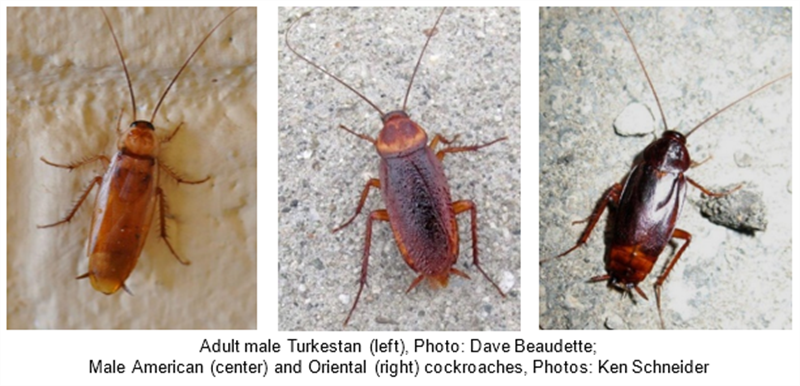
The cooler fall temperatures are finally here, bringing some relief from the low desert scorching summer temperatures! People have started preparing for the upcoming winter, and so have pests! It is never too cold in Arizona for some pests, but this is the time of the year when many common pests that normally thrive outdoors, move indoors seeking warmth and shelter within our homes and buildings. Here are some fall pests to watch out for:
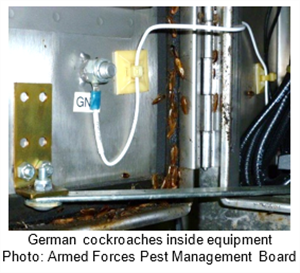 Cockroaches: There are many species of cockroaches that are pests in community environments. Some species, like American and Turkestan cockroaches are essentially outdoor cockroaches. When outside temperatures drop, these insects will start to move indoors through gaps or cracks under and around doors or windows, drainpipes, and other entry points.
Cockroaches: There are many species of cockroaches that are pests in community environments. Some species, like American and Turkestan cockroaches are essentially outdoor cockroaches. When outside temperatures drop, these insects will start to move indoors through gaps or cracks under and around doors or windows, drainpipes, and other entry points.
Generally, cockroaches are active by night and spend the daytime hiding. Sightings during the day may be indicative of significant infestations. Other signs of infestations include frass (insect poop), dead cockroaches, egg cases, shed skins and body parts.
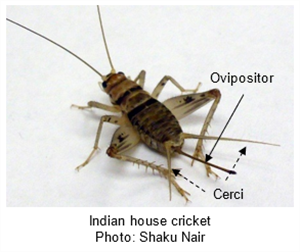 Crickets: Indian house crickets are medium sized wingless crickets, about 1 inch long when mature, and are the most common species found around human habitats. They are light yellowish brown or tan in color, and mottled with darker bands and spots. The wings appear as short stubs in females, while in males they cover only half the abdomen. Females have a very long and prominent ovipositor on their rear end, which is used to lay eggs. Female crickets do not sting. Either side of the long ovipositor on females are cerci. Male crickets have only cerci, which sense air currents in the insects surroundings. Crickets will readily enter buildings through gaps or cracks under doors, and will thrive indoors if food and water are available. They are harmless to humans, but are a food source for other predatory arthropods such as scorpions and spiders.
Crickets: Indian house crickets are medium sized wingless crickets, about 1 inch long when mature, and are the most common species found around human habitats. They are light yellowish brown or tan in color, and mottled with darker bands and spots. The wings appear as short stubs in females, while in males they cover only half the abdomen. Females have a very long and prominent ovipositor on their rear end, which is used to lay eggs. Female crickets do not sting. Either side of the long ovipositor on females are cerci. Male crickets have only cerci, which sense air currents in the insects surroundings. Crickets will readily enter buildings through gaps or cracks under doors, and will thrive indoors if food and water are available. They are harmless to humans, but are a food source for other predatory arthropods such as scorpions and spiders.
Termites: As the saying goes, “In Arizona, you either have termites or you’re going to get them”. Arizona is one of the places that have termite activity year-round. In the colder months, they may move deeper into the ground, but drywood and subterranean termites can be active in or near walls and foundations of buildings. Look out for mud tubes or piles of coffee grounds or sawdust-like termite frass, that are signs of activity.
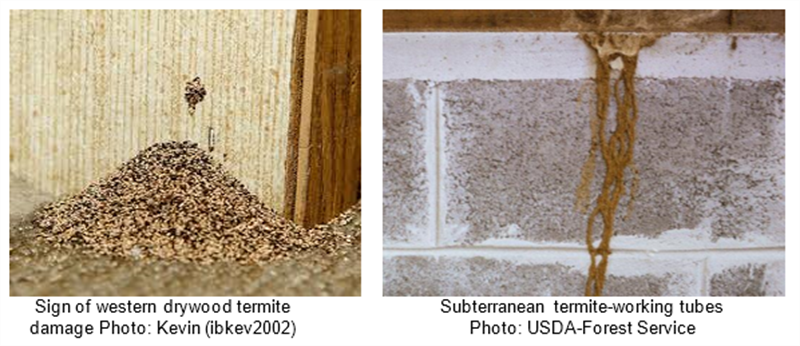
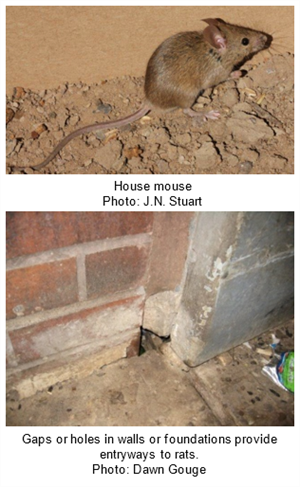
Rodents: Many commensal rodents, such as house mice and roof rats, will migrate indoors as the weather cools in search of warmth, shelter, food, and water. They will thrive in various suitable, undisturbed locations which have available food sources nearby. Because house mice are so small, they can gain entry into homes and other buildings much more easily than rats. House mouse infestations are probably 10 to 20 times more common than rat infestations.
Be on the lookout for droppings, chewed-up fruit or other items, signs of gnawing, pattering sounds from attics or wall voids.
Fleas: All rodents can host parasites such as fleas, mites and ticks, so an influx of rodents into homes and buildings can also bring in these parasites. Fleas are not adapted to survive cold temperatures outdoors, but they will thrive in the warm conditions indoors, and infest pets and other domestic animals.
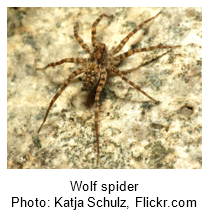 Spiders: Several outdoor spiders, such as wolf spiders, may wander indoors or closer to buildings in the fall in search of prey because many of their normal prey insect populations outdoors start declining.
Spiders: Several outdoor spiders, such as wolf spiders, may wander indoors or closer to buildings in the fall in search of prey because many of their normal prey insect populations outdoors start declining.
Pest-Proofing for Fall
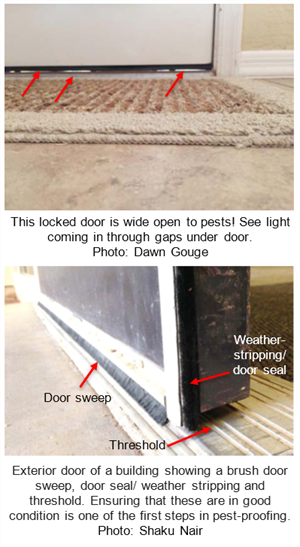 Many of the creatures we encounter in our homes can be prevented from entering in the first place by using simple techniques collectively referred to as “pest-proofing”. If done correctly, pest-proofing your home saves you money by reducing pest management costs, and more importantly, reduces indoor pesticide costs and exposure.
Many of the creatures we encounter in our homes can be prevented from entering in the first place by using simple techniques collectively referred to as “pest-proofing”. If done correctly, pest-proofing your home saves you money by reducing pest management costs, and more importantly, reduces indoor pesticide costs and exposure.
Below are ten pest-proofing tips from the National Pest Management Association to keep pests outside during the fall and winter:
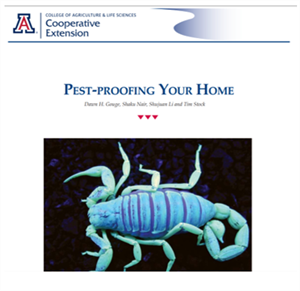 Pest-proofing your buildings is a good investment! A ‘hidden’ benefit of pest-proofing homes is an improvement in energy efficiency of the building, resulting in a welcome reduction in utility bills.
Pest-proofing your buildings is a good investment! A ‘hidden’ benefit of pest-proofing homes is an improvement in energy efficiency of the building, resulting in a welcome reduction in utility bills.
For more information on pests and pest-proofing, read our publication here: https://extension.arizona.edu/sites/extension.arizona.edu/files/pubs/az1677-2015.pdf
October Is National Children’s Health Month
 The U.S. Environmental Protection Agency (EPA) recognizes October as Children’s Health Month.
The U.S. Environmental Protection Agency (EPA) recognizes October as Children’s Health Month.
October 1st is the first day of Children’s Health Month. During October, EPA raises awareness about children's unique vulnerabilities to environmental exposures and focuses special emphasis on kid’s health through social media, events, and communication with partners. This year, we are happy to announce the release of 4 PSA videos. These videos can be shared with your partners or used or social media or other outreach as you determine appropriate. Here are the links for the PSAs:
Please help raise awareness about children’s environmental health risks during these special days of the month!
To spread public awareness of this important topic and provide information about ways people can protect children from a number of potential environmental exposure risks, the EPA has created a list of online educational resources, available here https://www.epa.gov/children/childrens-health-month-resources. The list covers topics ranging from mold and indoor air quality (IAQ) to lead in drinking water and protecting children from pesticides.
Read a blog by Centers for Disease Control and Prevention/Agency for Toxic Substances and Disease Registry (CDC/ATSDR) on Children’s Health Month here: https://blogs.cdc.gov/yourhealthyourenvironment/2019/10/02/childrens-health-month-october-2019/.
Webinars and Events
Southwest Termite Academy, October 23-24, 2019. Maricopa Agricultural Center, University of Arizona, Maricopa AZ. Details at: https://www.azppo.org/event-3508153.
Southwest Rodent Academy, December 4-5, 2019. Maricopa Agricultural Center, University of Arizona, Maricopa AZ. Details are coming soon.
Please join in for the 2019 All Bugs Good and Bad Webinar Series. This webinar series provides information about good and bad insects. Webinars are free and open to everyone. Webinars will be on the first Friday of each month at 2p.m. Eastern time.
Upcoming webinars include:
Spiders Commonly Found in Houses
Host: All Bugs Good and Bad Webinar Series
November 1, 11 a.m. Pacific
https://auburn.zoom.us/j/615766171
For more information about the EPA Schools program, visit: http://www.epa.gov/schools/

To view all our previous newsletters, visit: Home and School IPM Newsletters
Acknowledgements
This material is in part funded by the Extension Strategic Investment Fund 2018, and in part by the National Institute of Food and Agriculture, U.S. Department of Agriculture, under award number 2017-70006-27145 that provides Extension IPM funding to the University of Arizona. Additional support is provided by the University of Arizona – Arizona Pest Management Center.
